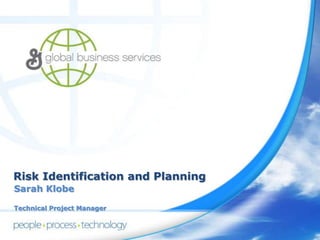Risk Assessment
- 1. Risk Identification and PlanningSarah KlobeTechnical Project Manager
- 2. Agenda10 PBED10 Risk Management Process Overview70 Risk Identification15 Break60 Risk Qualification60 Risk Response Plan15 PBED - Feedback/Debrief
- 3. Risk Management Process OverviewRisk Management PlanRisk IdentificationRisk Qualification Risk QuantificationRisk Response PlanningRisk Monitoring and Controlling
- 4. Risk IdentificationRisks can be good or bad!Risk Identification ToolsCharter
- 5. WBS
- 6. Network DiagramWrite well-defined risksBe CreativeDo not fill in Probability, Impact or CategoryDO NOT SOLVE!!!
- 7. Risk IdentificationWriting a Well-Defined RiskFollows the âCause-Risk-Effectâ formatDue to (definitive cause), (uncertain event) may occur which would/could/may lead to (effect)
- 8. Risk IdentificationIdentify as many risks as possibleWhat are risks related to this project as a whole?What are the related risks for each task?What are the risks by category?Be creative70 minutesReminder â Do NOT solve!
- 9. Risk QualificationProbability â the likelihood a risk will occurImpact â the effect the risk will have on the project if it occursRisk Ranking â Probability x Impact
- 10. Risk QualificationGoal â Identify the Top Risks vs. Non-Top RisksPlace your risks on the Probability & Impact ChartOnce all risks have been placed, Review risk ratings and mark risks you want to discuss
- 13. Must account for these in project planningIdentify ThresholdLogical break in risksIdentify Watch ListRisks that fall below the thresholdRisk Response PlanEliminate risk before it happensContingency Plan - IF the risk happens then do thisFallback Plan - IF the Contingency plan is not effective then do this
- 14. Risk Response PlanRisk TriggerAn early warning sign that a risk has occurred or is about to occurRisk OwnerA person who is assigned to watch for triggers and is responsible for carrying out the risk response plan if the risk occurs
- 15. Risk owners have valuable insight into risk analysis as well as planning responseRisk Response Plan
- 16. Feedback/DebriefWhat did you like?What didnât you like?How could this process be improved?PBEDThank you!!
Editor's Notes
- #4: There are 6 Process Areas for Risk ManagementRisk Management Plan â How we are going to handle risk on the project, who is involved, etc â talked about it in Kickoff meetingRisk Identification â Brainstorm as many risks as we can think of todayRisk Qualification â Involves assigning probability and impact to each risk to come up with risk rankingRisk Quantification â More technical than we are going to get into with this projectRisk Response Planning â Involves assigning owners to risks and identifying the BEST plan for dealing with identified risksRisk Monitoring & Controlling â We will continue to focus on risks through out the project â we will review them at every project team meeting and always be looking for new risks
- #5: Opportunities = good risksWBS â a âmapâ that includes all of the work to be done on the project. Also includes a WBS DictionaryNetwork Diagram â shows the interdependencies between tasks â tasks with more inputs and tasks on the right side of the diagram are inherently riskier
- #6: Formatting in this way will help us better understand exactly what the issue is and what effect it may have on the project.Ideas for responses are easier to generate if you have a detailed causeEffects could be more than time and cost â all components of the triple constraint â time, cost, scope, quality, risk, customer satisfaction
- #7: If people get stalled â hand out Risk Category sheetCould always try the Affinity Diagram if we have timeFill out categories after all risks have been identified
- #12: 3 Levels of Risk Response
- #14: Talk about example â Our project is to design a new piece of equipment that will be used to test water temperature and current flow in the ocean â must be tested prior to delivery
- #15: http://gmiportal.generalmills.com/tc/ci/CIPillars/PBED%20Database/Forms/AllItems.aspx













